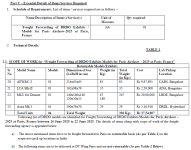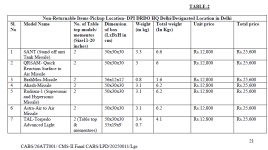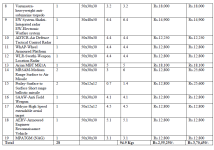Defence Research and Development Organisation (DRDO) : News and Updates
- Thread starter Ashwin
- Start date
You are using an out of date browser. It may not display this or other websites correctly.
You should upgrade or use an alternative browser.
You should upgrade or use an alternative browser.
'Major challenge is availability of propulsion systems': DRDO chairman Samir V. Kamat
Interview/ Dr Samir V. Kamat, secretary, Department of Defence Research and Development, and chairman, DRDO
Q/ With high-tech weapons changing modern warfare, which are the focus areas of research at DRDO?
A/ DRDO has identified nine thrust areas for focused research―platforms, weapon systems, strategic systems, sensors and communication systems, space, cyber security, artificial intelligence and robotics, material and devices, and soldier support. DRDO has been interacting with various defence ecosystem stakeholders to foster industry-academia cooperation to develop new technologies.
Q/ What is the progress in the development of UAS?
A/ In the smaller drone category (<100kg class), the country has the capability to design and develop indigenously for both civil and defence applications. Many private industries have already demonstrated that capability by supplying to civil and military organisations.
In case of short-range, MALE (medium-altitude, long-endurance) and HALE (high-altitude, long-endurance) UAVs (>100 kg), the design capability is limited to DRDO and HAL (Hindustan Aeronautics Limited). In that, there are challenges such as availability of suitable propulsion systems and optimum configuration customised to the propulsion systems. DRDO is also working on the design and development of MALE and HALE UAVs and weaponisation of UAVs. The technology readiness level is currently five and will be improved to seven in a time frame of five years for the MALE and HALE UAV class.
Q/ Despite having a growing ecosystem, why is India lagging in cutting-edge UAS platforms like Predators and Bayraktars?
A/ The major challenge is the availability of suitable propulsion systems to configure the UAVs. Even though the ecosystem is growing, it will take another five to ten years to bring the technologies for indigenous propulsion systems.
Q/ Which are the home-made UASs that DRDO has made for the military?
A/ Earlier, Lakshya aerial target system and Nishant UAVs were supplied to the Indian armed forces. The development of MALE UAVs is in progress. Currently, the Air Force and the Navy are exploring the feasibility of ordering 10 numbers (six for the IAF and four for the Navy) of Indian unmanned aerial system (IUAS), which are remotely piloted aircraft systems for the pre-operational role.
Q/ What kind of collaboration does DRDO have with the domestic private sector in making UAS?
A/ DRDO has carried out design and development through industry partners. In many of the critical subsystems, the design is carried out by DRDO and development through industry partners as build to print (where the manufacturer’s role is solely production). In many of the other subsystems, the design and development is done by DRDO through industry partners as build to specifications (where manufacturer handles design and production). As an example, in the case of MALE UAVs, there are nearly 70 airborne subsystems and 85 GOS (ground operational system) subsystems, which are certified and qualified. These are developed only through industry partners.
Q/ Are we looking at transfer of technology with global leaders in this sector?
A/ Only in the domain of propulsion systems. In certain niche technology areas for HALE UAVs, DRDO is collaborating with global leaders through consultancy and advisory mode, while the development will be done by DRDO based on the consultancy.
Loud mouth clowns, two years back was the date given for Archer-NG fight flight. Where is it now?
DRDO transfers technologies of nine systems to 10 industries
Posted On: 08 JUN 2025 4:28PM by PIB DelhiIn line with the Government’s vision to establish a robust defence industrial ecosystem with the participation of both public and private sectors, Vehicles Research & Development Establishment (VRDE), a DRDO laboratory located in Ahilyanagar, Maharashtra, has taken a major step forward by transferring technologies of nine systems to 10 industries. The licensing agreements were handed over in the presence of Secretary, Department of Defence R&D and Chairman, DRDO Dr Samir V Kamat during an event organised at VRDE on June 07, 2025. The technologies transferred to the industry are as follows:
| S No | Product/Technology | Industry Partner |
|---|---|---|
| 1 | Chemical, Biological, Radiological, Nuclear (CBRN) Recce Vehicle (Tracked) Mk-II | Bharat Electronics Limited |
| 2 | Mounted Gun System | Bharat Forge Limited |
| 3 | Anti-Terrorist Vehicle - Tracked Version | Metaltech Motor Bodies Private Limited |
| 4 | Full Trailer of 70t Tank Transporter for Main Battle Tank (MBT) Arjun Mk-1A | BEML Limited, Tata International Vehicle Applications, SDR Auto Private Limited, John Galt International |
| 5 | Expandable Mobile Shelter | Bharat Electronics Limited |
| 6 | Vajra-Riot Control Vehicle | Tata Advanced Systems Limited |
| 7 | Unit Maintenance Vehicle for MBT Arjun | BEML Limited |
| 8 | Unit Repair Vehicle for MBT Arjun | BEML Limited |
| 9 | Multi-Purpose Decontamination System | Dass Hitachi Limited, Goma Engineering Private Limited |
















